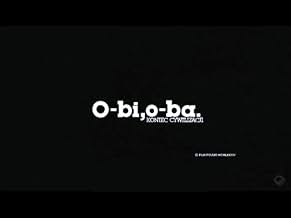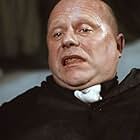IMDb RATING
7.2/10
2.2K
YOUR RATING
A man searches for survival after nuclear war forces people into an underground bunker. The inhabitants await rescue while their refuge decays around them.A man searches for survival after nuclear war forces people into an underground bunker. The inhabitants await rescue while their refuge decays around them.A man searches for survival after nuclear war forces people into an underground bunker. The inhabitants await rescue while their refuge decays around them.
- Awards
- 1 win total
- Director
- Writer
- All cast & crew
- Production, box office & more at IMDbPro
Featured reviews
A dystopian post-nuclear war society survives with enormous difficulties, while waiting for a miraculous rescue.
A dark but interesting vision, reminiscent of some comics from the 80s, such as Heavy Metal, of a post-nuclear future, condemned to crime and the fight for survival.
The faith of many and the madness of others is opposed to the skeptical lucidity of the elites, who seek an unlikely solution for an almost impossible survival.
Die now or live another day? It seems to be the essential question posed to these survivors, increasingly tired of their fortune.
It certainly deserves to be seen, especially by fans of dystopian and post-apocalyptic themes.
A dark but interesting vision, reminiscent of some comics from the 80s, such as Heavy Metal, of a post-nuclear future, condemned to crime and the fight for survival.
The faith of many and the madness of others is opposed to the skeptical lucidity of the elites, who seek an unlikely solution for an almost impossible survival.
Die now or live another day? It seems to be the essential question posed to these survivors, increasingly tired of their fortune.
It certainly deserves to be seen, especially by fans of dystopian and post-apocalyptic themes.
Nothing for the post-apocalyptic action junkie but for those who like a story with some depth. Sadly, I had to watch a bad quality copy on YouTube, luckily that one got subtitles. Good if you are on the look out for something that provides a dystopian story that does not follow the path of Mad Max and its countless clones, but tries to give us a more realistic impression on a world after total mayhem. Recommended if you like movies a la The Day After, Thread etc.
Delving deep into the dusty and long abandonded vaults of b-cinema in search of lost gems always leaves me with a bittersweet taste. On one hand the discovery of unexpected gems where no one would think them possible is a rewarding experience. On the other hand though it makes one wonder how many of these remarkable low-budget oddities, personal love affairs of directors never quite famous and now all but forgotten, have almost forever slipped from memory?
In any case what we have here is a little post-apocalyptic gem from Poland that is really better than it has any right to. The dystopian near future of O-BI, O-BA finds a group of survivors of the nuclear war that ravaged the Earth inhabiting an underworld concrete bunker and biding their time as they wait for the mysterious Ark, an air ship of some kind that will come and save them. The Ark proves to be an elaborate hoax, carefully designed to give hope to the malnourished and desperate denizens of the bunker, while in the meantime the dome that separates their miserable existence from the nuclear winter outside is slowly caving in.
What first striked me about the movie is the design of the bunker and the depiction of the survivors. The survivors are gaunt, filthy and terrible-looking penitents, dressed in rags and aimlessly wandering the neon-lit halls of the bunker like automatons. The bunker is a rundown, seedy place, with bright neon lights peering from all sides like the eyes of malignant beasts.
On one hand it is a slightly 80's depiction of the dystopian future but the movie never stoops down to MAD MAX cheese. Instead it combines biting political satire with the bleak outlook of a world with no future, black comedy with barbs on apathy, religion and power. The survivors, for example, are fed some kind of flour dropping from a tube that hovers in the air - later on we discover the food supervisor uses books and the Bible itself as filler for this meagre meal. There are many such short symbolic touches, perhaps not life-changing or faith-restoring, yet playful, clever and inspired.
One thing is for sure; O-BI, O-BA is not your run-of-the-mill sci-fi schlock. It overcomes its modest budget with creativity and has genuine artistic aspirations both from a writing and directing perspective. My opinion is that it should have been filmed in black and white instead of colour though. The director uses atmospheric light and shadow to great effect and it would have registered even better in stark black and white. The blue-green neon on the other hand outstays its welcome after a while. Just a minor gripe in an otherwise solid b-movie with its heart set in all the right places.
Imagine a less bleak THE ROAD (Cormac McCarthy) being injected with the satire and humour of DR.STRANGELOVE and you're getting there. See it if you can find it.
In any case what we have here is a little post-apocalyptic gem from Poland that is really better than it has any right to. The dystopian near future of O-BI, O-BA finds a group of survivors of the nuclear war that ravaged the Earth inhabiting an underworld concrete bunker and biding their time as they wait for the mysterious Ark, an air ship of some kind that will come and save them. The Ark proves to be an elaborate hoax, carefully designed to give hope to the malnourished and desperate denizens of the bunker, while in the meantime the dome that separates their miserable existence from the nuclear winter outside is slowly caving in.
What first striked me about the movie is the design of the bunker and the depiction of the survivors. The survivors are gaunt, filthy and terrible-looking penitents, dressed in rags and aimlessly wandering the neon-lit halls of the bunker like automatons. The bunker is a rundown, seedy place, with bright neon lights peering from all sides like the eyes of malignant beasts.
On one hand it is a slightly 80's depiction of the dystopian future but the movie never stoops down to MAD MAX cheese. Instead it combines biting political satire with the bleak outlook of a world with no future, black comedy with barbs on apathy, religion and power. The survivors, for example, are fed some kind of flour dropping from a tube that hovers in the air - later on we discover the food supervisor uses books and the Bible itself as filler for this meagre meal. There are many such short symbolic touches, perhaps not life-changing or faith-restoring, yet playful, clever and inspired.
One thing is for sure; O-BI, O-BA is not your run-of-the-mill sci-fi schlock. It overcomes its modest budget with creativity and has genuine artistic aspirations both from a writing and directing perspective. My opinion is that it should have been filmed in black and white instead of colour though. The director uses atmospheric light and shadow to great effect and it would have registered even better in stark black and white. The blue-green neon on the other hand outstays its welcome after a while. Just a minor gripe in an otherwise solid b-movie with its heart set in all the right places.
Imagine a less bleak THE ROAD (Cormac McCarthy) being injected with the satire and humour of DR.STRANGELOVE and you're getting there. See it if you can find it.
In the aftermath of a nuclear war, the last survivors are jammed together under one giant concrete dome, which is protecting the remnants of human civilization from the deadly atomic winter. As resources grow scarce people become more and more rampant, eagerly awaiting the arrival of a fabled Ark which is supposed to save them all. Amidst this mess we find Soft, whose job is to check the structural stability of their shelter. When he discovers that the dome is close to collapsing, he plunges himself into the pandemonium of the last human civilization in order to find out more about this mythical Ark.
I was able to watch a subtitled version of 'O-Bi O-Ba - The End of Civilization' at a festival, which had a segment dedicated to Eastern European sci-fi flicks. I didn't know what to expect - none of the actors rang any bells, neither did the director. Boy, was I in for a surprise! The acting is very solid throughout the movie, I especially liked the laconic fatalism of Soft's boss (Marek Walczewski) and the performances of Jan Nowicki as the Engineer, and of Soft himself (Jerzy Stuhr) who acts as our guide into the depth of the dome, and does a wonderful job of trying to keep calm and rationalize his way out of certain doom.
What struck me most, though, is that this movie works perfectly as an post-apocalyptic dystopia. It displays the (at times pointless) struggle of Soft against his and the others' fate, while at the same time painting a very dark and cynical portrait of human society living on borrowed time on the brink of certain oblivion. As we follow Soft into the underbelly of the dome's society, we discover its secrets layer by layer and realize how paper-thin the wall between madness and reason really is. I am not overly familiar with the circumstances in which the movie was made (it was shot when Poland was still a Socialist Republic), but the social commentary is quite clear. The movie lends itself to be read as criticism of a capitalist society, basically (and at times quite literally) devouring itself. My guess is that it works both ways and can also be applied as an attack on Socialist societal mechanisms (as the movie was shot during the last years of collapsing Polish Socialsm), but I'd venture on very thin ice if I were to substantialize this claim.
At the very least, this film revolves around the human condition and contests if the human race has grown in any way over the last centuries and millenia. Great stuff, go see it if you have the chance - especially if you're a fan of dystopian fiction!
I was able to watch a subtitled version of 'O-Bi O-Ba - The End of Civilization' at a festival, which had a segment dedicated to Eastern European sci-fi flicks. I didn't know what to expect - none of the actors rang any bells, neither did the director. Boy, was I in for a surprise! The acting is very solid throughout the movie, I especially liked the laconic fatalism of Soft's boss (Marek Walczewski) and the performances of Jan Nowicki as the Engineer, and of Soft himself (Jerzy Stuhr) who acts as our guide into the depth of the dome, and does a wonderful job of trying to keep calm and rationalize his way out of certain doom.
What struck me most, though, is that this movie works perfectly as an post-apocalyptic dystopia. It displays the (at times pointless) struggle of Soft against his and the others' fate, while at the same time painting a very dark and cynical portrait of human society living on borrowed time on the brink of certain oblivion. As we follow Soft into the underbelly of the dome's society, we discover its secrets layer by layer and realize how paper-thin the wall between madness and reason really is. I am not overly familiar with the circumstances in which the movie was made (it was shot when Poland was still a Socialist Republic), but the social commentary is quite clear. The movie lends itself to be read as criticism of a capitalist society, basically (and at times quite literally) devouring itself. My guess is that it works both ways and can also be applied as an attack on Socialist societal mechanisms (as the movie was shot during the last years of collapsing Polish Socialsm), but I'd venture on very thin ice if I were to substantialize this claim.
At the very least, this film revolves around the human condition and contests if the human race has grown in any way over the last centuries and millenia. Great stuff, go see it if you have the chance - especially if you're a fan of dystopian fiction!
O-bi O-ba, through the dystopian Illustrating of a micro-society set in an underground dungeon after a nuclear holocaust, is surprisingly perfect. The story follows a wandering hero through different landscapes that dominate each of the levels of the refuge.
It was released in 1985, the same year as another, quite similar film: Terry Gilliam's Brazil. Perhaps something was in the air over all of Europe at the time, something moving freely and without heed of the iron curtain, something grotesque enough to bend men's minds to craft images like this one:
With a budget that we can easily guess very limited, produced in a country of the communist bloc only a few years before the collapse of the USSR, the Polish director Piotr Szulkin has succeeded beyond all these constraints to create a minimalist yet coherent and very immersive science-fiction universe. The film offers a dark and hopeless atmosphere, in an oppressive environment, here people cling on a belief, of a prophecy - the Ark. Its a metaphorical bomb all around with many possible interpretations.
Alongside Soft, the protagonist, we are gradually discovering the different layers constituting the lie, this mirage which maintains order in this society. Under these conditions, a handful of men is enough to keep the control mechanisms operational, and work to ensure that they remain so once the Dome is shattered, one step ahead of its inhabitants, obsessed with their survival and their salvation. The Dome and the Ark, the Soviet grip and the mirage of the West, is only one among many interpretations that can be found inO-bi, O-ba, political, religious or emotional. There remains a particularly desperate look on the enslaving power of belief, on the predisposition of some to embrace it and on the will of others to exploit it.
It was released in 1985, the same year as another, quite similar film: Terry Gilliam's Brazil. Perhaps something was in the air over all of Europe at the time, something moving freely and without heed of the iron curtain, something grotesque enough to bend men's minds to craft images like this one:
With a budget that we can easily guess very limited, produced in a country of the communist bloc only a few years before the collapse of the USSR, the Polish director Piotr Szulkin has succeeded beyond all these constraints to create a minimalist yet coherent and very immersive science-fiction universe. The film offers a dark and hopeless atmosphere, in an oppressive environment, here people cling on a belief, of a prophecy - the Ark. Its a metaphorical bomb all around with many possible interpretations.
Alongside Soft, the protagonist, we are gradually discovering the different layers constituting the lie, this mirage which maintains order in this society. Under these conditions, a handful of men is enough to keep the control mechanisms operational, and work to ensure that they remain so once the Dome is shattered, one step ahead of its inhabitants, obsessed with their survival and their salvation. The Dome and the Ark, the Soviet grip and the mirage of the West, is only one among many interpretations that can be found inO-bi, O-ba, political, religious or emotional. There remains a particularly desperate look on the enslaving power of belief, on the predisposition of some to embrace it and on the will of others to exploit it.
- How long is O-Bi, O-Ba: The End of Civilization?Powered by Alexa
Details
- Release date
- Country of origin
- Language
- Also known as
- О-би, О-ба - Конец цивилизации
- Production company
- See more company credits at IMDbPro
Contribute to this page
Suggest an edit or add missing content

Top Gap
By what name was O-Bi, O-Ba: The End of Civilization (1985) officially released in India in English?
Answer


































